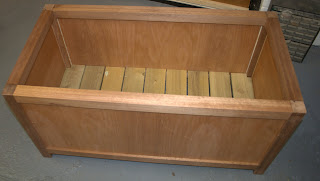I saw an article the other day in a newspaper that stated "When buying furniture ask if the timber used has come from accredited sources"
I looked into this and found that all the timber I use in my products is supplied by companies that are accredited by FSC and PEFC. Below are details of what they do.
I can now rest assured that my products use timber that comes from sustainable resources.
What is FSC?
Wood is one of the few materials which can be described as truly sustainable. Some of our best loved and ecologically rich ancient woodlands have supplied timber for ships, houses and furniture for thousands of years.
But more and more people are rightly concerned that the wood they are using might be contributing to the destruction of forests around the world. Forest Stewardship Council (FSC) is an international non-profit organisation dedicated to the promotion of responsible forest management.
 What is the Forest Stewardship Council?
What is the Forest Stewardship Council?
The Forest Stewardship Council (FSC) has developed a unique system of independent forest certification and product labelling, helping consumers identify timber and products from responsibly managed woodlands. The FSC is an independent, non-profit, non-governmental organisation (NGO).
What is certification?
Certification is the process of inspecting forests to assess their management according to an agreed set of principles and criteria. These include recognition of indigenous peoples' rights, long term economic viability and protection of wildlife. A wide range of forests have already been certified, from Swedish pine plantations to tropical rainforests in Brazil.
Who supports FSC?
The FSC system is backed by a range of environmental organisations. These include WWF, Friends of the Earth, Greenpeace, the National Trust and the Woodland Trust, as well as major companies, trade unions and other social groups.
Will it really make a difference?
Yes, the FSC logo shows that timber comes from responsibly managed forests. More FSC products mean that more FSC certified forests are being managed for the long-term well being of people and the planet.
How does it work?
FSC has developed ten rules, or principles, that define good management. These principles are global they can apply to any forest any where in world.
Principles for forest stewardship:
- Compliance with laws and FSC principles
- Rights and responsibilities relating to land tenure and use
- Indigenous peoples’ rights
- Community relations and workers' rights
- Benefits from the forest
- Environmental Impact
- Management plan
- Monitoring and assessment
- Maintenance of high conservation value forests
- Plantations.
What is PEFC?
The PEFC council (Programme for the Endorsement of Forest Certification schemes) is an independent, non profit, non-governmental organisation, founded in 1999 which promotes sustainably managed forests through independent third party certification.

The PEFC provides an assurance mechanism to purchasers of wood and paper products that they are promoting the sustainable management of forests. PEFC is a global umbrella organisation for the assessment of and mutual recognition of national forest certification schemes developed in a multi-stakeholder process. These national schemes build upon the inter-governmental processes for the promotion of sustainable forest management, a series of on-going mechanisms supported by 149 governments in the world covering 85% of the worlds forest area.
The PEFC schemes account for over 126 million hectares of certified forests producing millions of tonnes of certified timber to the market place making PEFC the worlds largest certification scheme.















